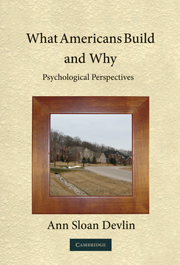Book contents
- Frontmatter
- Contents
- List of Figures
- Preface
- Acknowledgments
- 1 The Landscape of Housing: Suburbia, New Urbanism, and McMansions
- 2 The Landscape of Health Care: High Tech and Humanistic
- 3 The Landscape of Schools: Big Schools, Small Schools
- 4 The Landscape of Work: Visible or Virtual?
- 5 The Landscape of Retail: Big Box and Main Street
- Closing Comments
- Index
1 - The Landscape of Housing: Suburbia, New Urbanism, and McMansions
Published online by Cambridge University Press: 05 June 2012
- Frontmatter
- Contents
- List of Figures
- Preface
- Acknowledgments
- 1 The Landscape of Housing: Suburbia, New Urbanism, and McMansions
- 2 The Landscape of Health Care: High Tech and Humanistic
- 3 The Landscape of Schools: Big Schools, Small Schools
- 4 The Landscape of Work: Visible or Virtual?
- 5 The Landscape of Retail: Big Box and Main Street
- Closing Comments
- Index
Summary
PERSONAL REFLECTIONS
When I first visited Seabrook, Maryland, the home of a college friend, I felt like Gertrude Stein describing Oakland, California. “That can't be a town,” I said, “because there is no there, there.” Seabrook was off the Beltway surrounding Washington, D.C., about 12 miles east of the city. Primarily residential, Seabrook was developed during the 1950s to provide housing for employees in government agencies, such as the Goddard Space Flight Center and the National Security Agency, where my friend's father worked. I came from a different residential experience. I grew up in a university town, Ann Arbor, Michigan, which definitely had a “there, there,” and I was less accustomed to using the car. I walked to high school in good weather, to Burns Park, to the Food and Drug Mart (a small grocery/convenience store), the Ann Arbor Bank (for my Christmas Club account), and the Dairy Queen, all important destinations. In all honesty, mothers with five children in the 1950s (as was true for my mother) were probably more willing to let their children wander a far distance from home than they would let them today!
When my spouse and I bought our house, we looked for a place where we could walk downtown. More than 30 years later, we still live in that house on Elm Street in that small town: Mystic, Connecticut. Settled in the 1650s along the banks of the Mystic River, Mystic has one main street (Main Street) and about 4000 residents, according to the 2000 Census.
- Type
- Chapter
- Information
- What Americans Build and WhyPsychological Perspectives, pp. 1 - 68Publisher: Cambridge University PressPrint publication year: 2010



